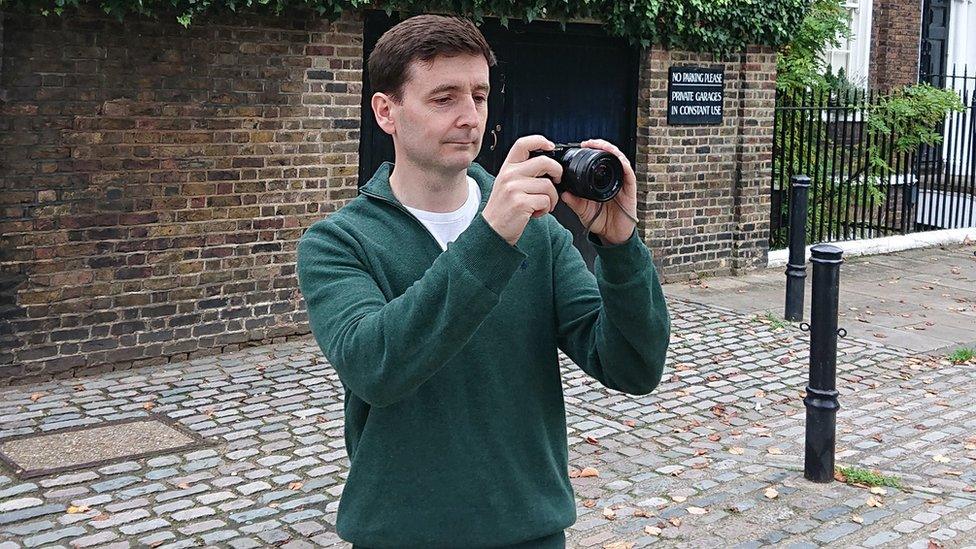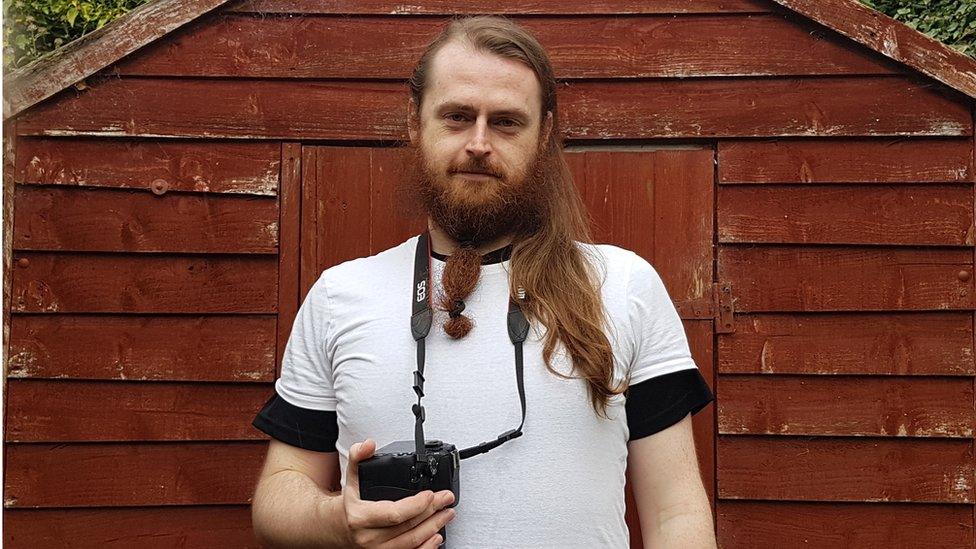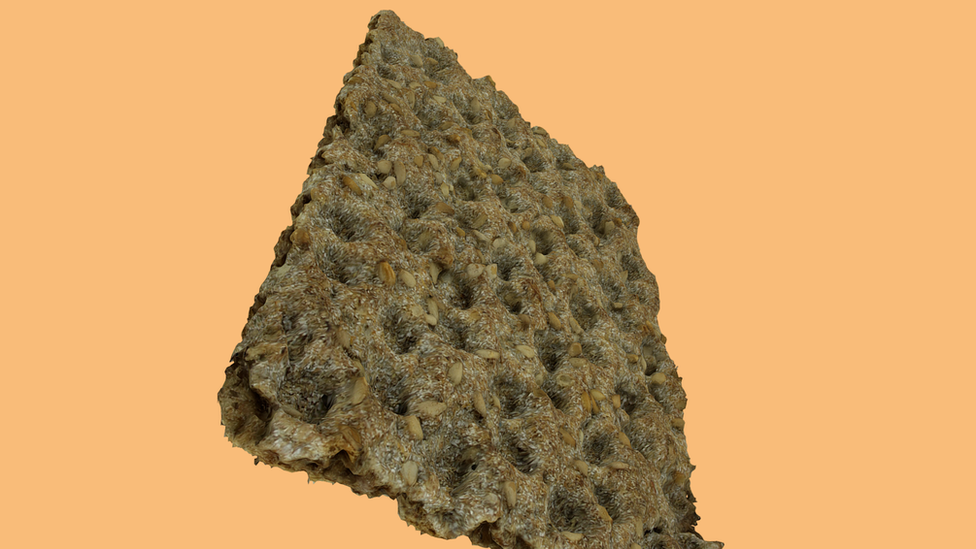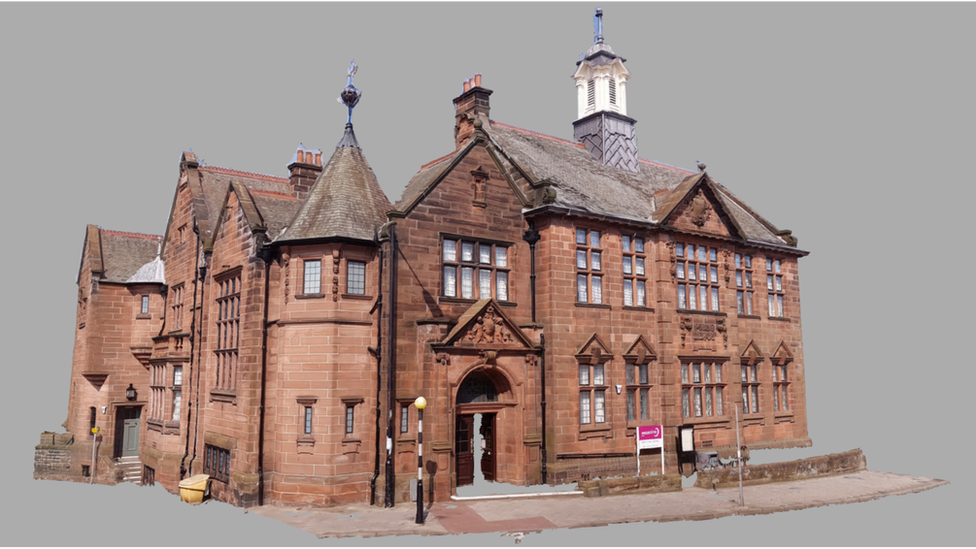The photographers capturing buildings and biscuits in 3D
- Published

David Fletcher wants to create an accurate record of what objects look like
When the first lockdown was eased in June, David Fletcher picked up his digital camera and got to work. Save for a few police officers and builders, he says, London's streets were deserted.
But that suited him just fine. He wanted to take photographs without people getting in the way. Mr Fletcher takes thousands upon thousands of images of a façade or area and later uses computer software to stitch these images together as a 3D model.
The process is called photogrammetry and while he's been dabbling in it for many years, he's been able to indulge his hobby to an even greater extent during the pandemic.
"It's a lot easier to take photographs without disturbing people, I just go for long walks around the city finding things," he says.
From ornate Victorian buildings, external, to the Southbank skatepark's graffiti-rich concrete pillars, external, Mr Fletcher's collection of digital landmarks is as diverse as London's cityscape itself. He publishes several new models online every week.

The Great Chamber at London's Charterhouse is one of many landmarks captured by David Fletcher
Photogrammetry has been around for more than 150 years in various forms and has been used before by cultural institutions and private firms as a means of preserving artefacts of historical importance, including those at risk of destruction in war zones.
But the dwindling cost of digital cameras and the availability of software that automatically turns photographs into 3D reconstructions has meant amateurs are increasingly taking up this digital preservation as a hobby.
There are many like Mr Fletcher, keen to capture historical sites and urban environments for posterity. And once a 3D model has been made, it can be used for all manner of things.
Mr Fletcher, who works as a digital artist in the video games industry, says others sometimes download his models and insert them into games.
His Southbank skatepark was quickly turned into a virtual reality hangout space, external and game location for people to play in, external, for example.
Allow X content?
This article contains content provided by X. We ask for your permission before anything is loaded, as they may be using cookies and other technologies. You may want to read X’s cookie policy, external and privacy policy, external before accepting. To view this content choose ‘accept and continue’.
He publishes his models freely online so they can be used for creative projects. But this year, he's also been contacted by people who say they enjoy looking at his models simply because they represent locations they used to pass daily on their way to work - but which they haven't been to for months due to Covid-19.
Mr Fletcher's own motivation is to make a record of what things currently look like. Sometimes, museums or heritage sites ask him to make models for them, which he often does for free.


Each library of photos of a particular subject takes a day or two to be processed automatically on his PC. He'll then spend a few more days correcting errors or adjusting jagged edges and imperfections. Should the building or object in question be removed or damaged in the future, he adds, at least his scan will have preserved what it looked like.
"I don't think my scans are ever perfect," says Mr Fletcher. "But… at least it's been recorded in some way in 3D."

Daniel Muirhead would like to capture all of Scotland's cities
Another enthusiast who hopes to capture the world around him via photogrammetry is Daniel Muirhead, who lives in Fife, in Scotland.
He's made digital models of buildings in Dundee, Edinburgh and Arbroath, external among other places.
"My ultimate goal is to have a photorealistic, high-quality, full-scale reproduction of all the urban centres in Scotland," he says.
His hobby gives him an excuse to get out and explore while being creative, he adds, though during lockdown in the spring he had to make do with scanning items in his flat - including biscuits and snacks.
These provided mildly comical subjects but ones that also presented good technical challenges for modelling because they were small and detailed, he says. Take this slice of crispbread, for instance.

Rough surfaces are easier for photogrammetry software to process
Its craggy, pock-marked surface and encrusted grains are suitable for photogrammetry because the software that stitches photos together often struggles to do so accurately if the subject is smooth or shiny.
Mr Muirhead says he hopes his scans of historical sites and interesting buildings will encourage people to visit new places.
This could indeed have the desired effect, says Ardern Hulme-Beaman, who uses photogrammetry in his research at the University of Liverpool, external.
He points to the museums that have put 3D scans of artefacts online - such as the London Museum, external, for instance. Dr Hulme-Beaman says these collections often prompt people to make a personal visit in person, and he is impressed with the standard of the 3D captures made by enthusiasts like Mr Fletcher and Mr Muirhead.
"Some of the quality of the models is just, it's through the roof," he says.

Montrose Public Library
His archaeology colleges at Liverpool University have been using 3D scans of artefacts in online teaching sessions during the pandemic. Usually students would be able to directly handle these objects, but with Covid-19 restrictions in place the digital alternatives are "the next best thing", he explains.
It's a view shared by Abby Crawford of Sketchfab, a website where modellers can share their creations. She herself has helped a teacher friend of hers design a project for archaeology students, featuring 3D models of Roman artefacts that were made by hobbyists and others.
Dr Crawford, who worked with Mr Fletcher on an article about his 3D models, external, thinks we will see more of the world preserved digitally in 3D due to Covid: "2020 has been a catalyst for people to digitise more, and appreciate the things that have been digitised that they can't see in person."